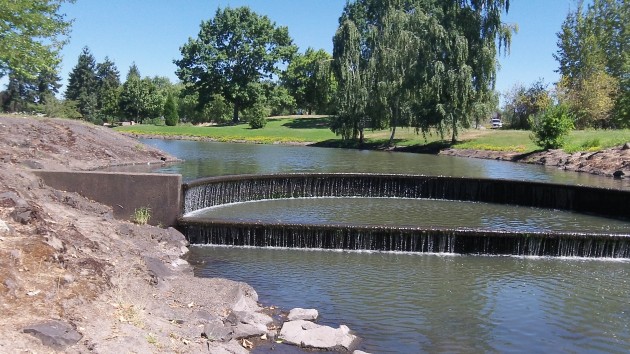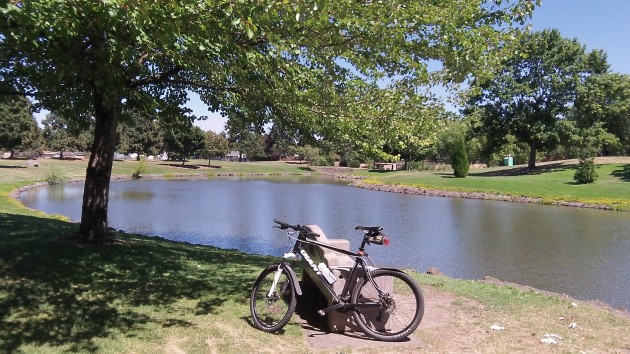If we needed another reason to value and maintain the Albany-Santiam Canal, we’re seeing it now. We’re seeing it in the creeks that keep flowing through town and are keeping water in the ponds of city parks despite this summer’s drought and unusual heat.
I thought of this the other day on a little ride along the Periwinkle Bike Path. The path takes the rider past the ponds in Grand Prairie and Periwinkle parks. Both were filled to the brim, thanks to the fact that water was flowing in Periwinkle Creek, normally fed by seasonal runoff. Even though it hasn’t rained for a long time, the stream still flows because it gets water from the canal, diverted where the creek bed and the canal cross each other east of Three Lakes Road.
This week Periwinkle is receiving about 5 cubic feet of water per second in this way, I learned from Chris Bailey of Albany Public Works. The other streams that enliven Albany’s urban neighborhoods also are flowing with canal water. Cox Creek gets about 9 cfs, Cathey Creek about 5, and the Eighth Avenue Canal just a trickle, about 1 cfs. All of them would likely be dry by August, especially this year, without the canal as a source.
The canal, as you know, takes water from the South Santiam River above Lebanon and carries is 18 miles to Albany, which has water rights to supplement the local streams. The canal used to be Albany’s only domestic water source until the city and Millersburg built the Scravel Hill treatment plant on the Santiam River about 10 years ago. Now it still supplies a portion of Albany’s drinking water, especially when demand is high.
But even if the canal were not still needed for that, without it Albany’s summertime streams likely would be nothing but mud or even dust. (hh)




And why does the water still flow from the S. Santiam River? Primarily because of the impoundments (dams) on the river that maintain the year-round flow of water. In our area that means Foster and Green Peter dams and reservoirs, which hold the water in wet times for use in dry weather. And yet in our (Democrat) Governor’s pronouncements on the “new normal” of climate change we see nothing of developing new dams to meet the needs of a growing population. Instead its all about spreading the misery around and increasing costs (taxes), not creating solutions. Down in California they are paying the price of not seeing the obvious necessity to meet the water needs of a growing population. Instead the politicians and environmentalists unfairly blame farmers for their own folly of a no-growth attitude while allowing or even promoting population growth. Oregon used to take pride in not following the foolish path of our southern neighbors. Apparently not any more. Its the Progressive way, dontcha know.
“…we see nothing of developing new dams to meet the needs of a growing population.”
Simply building additional dams won’t accomplish what you’re asking IMO. When you look around the region and see the lack of in-flow to fill even the existing “lakes” behind the dams (Detroit for one) and the cost of building a new dam, I don’t see any inherent advantage to making more of them.
Ray,
That’s because, like almost everything else, the left has found “reasons” why dams aren’t good, and have convinced the electorate that they cause more harm that good.
This year is a PRIME example of the fallacy in that argument.
On the Santiam system, the Cascadia dam was thwarted in the late 60’s-early 70’s due to environmental and scenic reasons. At that time it was acceptable….but today, what would the impoundment of that water be worth? Anyone familiar with the water temps of Green Peter as opposed to Foster will understand. Foster is SEVERAL degrees cooler than Green Peter in the summer. Always has been. What would that be worth to the salmon/steelhead populations this year?
We are very LUCKY to live where we do, where water shortages can be mitigated by the impoundments in place. Just imagine the regulatory costs of constructing that “shovel ready” design from the early 70’s now?” Forget it……..Triple the cost, AFTER inflation.
Such is the price of economical development in today’s world.
“Just imagine the regulatory costs of constructing that “shovel ready” design from the early 70’s now?” Forget it……..Triple the cost, AFTER inflation.”
(If you’re lucky…) You’re 100% correct. But until/if/when you can do so while maintaining the quality of life we value in Oregon…never going to happen.
I think the point being made is that dams can hold some of the “inflow” during the wet years and act as a buffer for the dry years.
It hasn’t been that long since we had a large ‘inflow”.
http://www.gazettetimes.com/news/local/the-flood-of/article_96c74746-4339-11e1-be3a-0019bb2963f4.html
Back to the real point: It’s not a shortage of dams causing drought, it’s a shortage of snow.
If you know anything about management of reservoirs, they need to have storage water decreased in the late fall and early winter so they can be refilled when the snows melt in spring. No snow, no water.
Since most the major watersheds in the Cascades ALREADY send water to a reservoir system of one sort or another, where do you intend to find this NEW water? Just dry up the Santiam and Willamette each spring until the dams are filled?
Next, lets talk about how you radical right wingers scream bloody murder anytime government goes forward to build new things. Fine. So get off your butts and come up with the hundreds of millions of dollars, or maybe even a billion, needed to make each major new dam from the private sector. I guess if Pacific Power were to do it for power generation, they could just add another $50 a month to your power bill to get the cash.
But there is another way since you all are worried so much, that would not cost Oregonians anything..
Every couple of years, rumbles come from California to reroute water from the Columbia and Oregon to their state so that they can fuel their growth. They are willing to pay for it. More dams will make you happy, right? There you go…
Bob, Tell us something we don’t already know, and quit insulting our intelligence.
“….radical right wingers…..” There goes Bob again, from the far left! It also occurs to me that in California, you would blend right in. There’s some cheap real estate down on the Salton Sea.
Ray,
You’re being deliberately obtuse. I didn’t say, “simply building dams” was the only thing to do. But it would go a long way to mitigating the problem. And be a much better option than giving the leviathan state more control over our lives.
True — you didn’t say “simply building dams…” You said: “…we see nothing of developing new dams…” I also said “inflow” — which quite easily extrapolates to lack of snow (and rain). When was the last time any “dam” was built solely for the purpose of impounding water?
RayK
Nice informative article Hasso.
And here’s an Op-Ed piece from today’s NY Times on how California is doing with water:
http://www.nytimes.com/2015/08/16/opinion/sunday/how-california-is-winning-the-drought.html